Crown-cardinal

| Part of a series on the |
| Hierarchy of the Catholic Church |
|---|
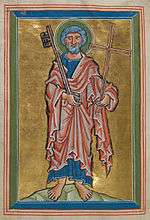 |
| Ecclesiastical titles |
|
|
Liturgical titles |
|
Administrative and pastoral titles
|
|
Consecrated and professed titles |
|
|

A crown-cardinal (Italian: cardinale della corona)[1] was a cardinal protector of a Roman Catholic nation, nominated or funded by a Catholic monarch to serve as their representative within the College of Cardinals[2][3] and, if applicable, exercise the jus exclusivae.[4] More generally, the term may refer to any cardinal significant as a secular statesman or elevated at the request of a monarch.
Francis Burkle-Young defines a crown cardinal as one "elevated to the cardinalate solely on the recommendation of the European kings and without, in many cases, having performed any service at all for the advance of the Church."[5]
According to conclave historian Frederic Baumgartner, the crown-cardinals "rarely came to Rome except for the conclaves, if then, and they were largely unknown to the majority of the College. Usually unable to take part in the pratiche, they were not papabili and rarely received more than one or two votes".[6] Crown-cardinals generally opposed the election of crown-cardinals from other kingdoms, although they tended to unite against the election of cardinal-nephews.[6]
Opposition to national cardinal protectors arose in the fifteenth century due to the perceived conflict of interest, and Pope Martin V attempted to forbid them entirely in 1425.[7] A reform of Pope Pius II dated 1464 regards national cardinal protectors as generally inconsistent with curial responsibility, with several exceptions.[7] Such protectorships were first openly permitted by popes Innocent VIII and Alexander VI, both of whom required the explicit written consent of the pontiff for a cardinal to take up a "position of service to a secular prince".[8] An unnamed cardinal even suggested elevating national cardinal protectors to a full and official position in the Roman Curia, equivalent to an ambassador.[8]
History
The institution of a cardinal protector of a nation-state may have originated in the 14th century, serving as a predecessor for the diplomatic institutions of the Holy See developed in the 16th century.[9] The institution of the crown-cardinal first became a dominant one within the College of Cardinals with the consistory of Pope Eugene IV on December 18, 1439 (on the heels of the election of Antipope Felix V by the Council of Basel), which nominated an unprecedented number of cardinals with strong ties to European monarchs and other political institutions.[10]
| Monarch/Nation | Cardinal | Notes |
|---|---|---|
| Charles VII of France | Renaud de Chartres | Chancellor of France |
| Charles VII of France | Guillaume d'Estouteville | Royal cousin, constructor of Mont Saint-Michel |
| Henry VI of England | Louis de Luxembourg de Beaurevoir | Chancellor for France |
| Henry VI of England | John Kempe | former chancellor of England and archbishop of York |
| Afonso V of Portugal | António Martins de Chaves | Bishop of Porto |
| Kingdom of Hungary (interregnum) | Dionysius Szechy | Primate-designate of Hungary |
| Władysław III of Poland | Zbigniew Oleśnicki | Archbishop of Kraków |
| Holy Roman Empire (interregnum) | Petrus de Schaumburg | Imperial Counsellor |
| René I of Naples | Niccolo d'Acciapaccio | Archbishop of Capua |
| Milan | Gerardo Landriani Capitani | Bishop of Como |
| Genoa | Giorgio Fieschi di Lavagna | Archbishop of Genoa |
| Philip the Good | Jean Le Jeune | Ambassador to the Council of Ferrara-Florence |
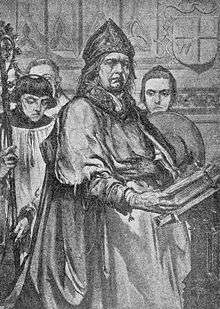
The first explicit reference to protectorship pertaining to a nation-state dates to 1425 (the Catholic Encyclopedia says 1424[11]) when Pope Martin V forbade cardinals to "assume the protection of any king, prince or commune ruled by a tyrant or any other secular person whatsoever."[12] This prohibition was renewed in 1492 by Pope Alexander VI. This prohibition was not renewed by Pope Leo X in the ninth session of the Lateran Council of 1512.[11]
Some crown-cardinals were cardinal-nephews or members of powerful families; others were selected solely on the recommendation of European monarchs, in many cases with little previous ecclesiastical experience.[13] During the reigns of Avignon Pope Clement VI and Pope Urban VI in particular, it was acknowledged that monarchs could select retainers and expect them to be elevated to the College of Cardinals.[13] The going rate for the creation of a crown-cardinal was about 2,832 scudi.[2]
Pope Alexander VII had to elevate crown-cardinals in pectore.[14] Pope Urban VI (1378–1389) forbade crown-cardinals from receiving gifts from their respective sovereigns.[11]
World War I cemented the decline of the institution of the crown cardinal, as many monarchies either became extinct or declined in power.[13]
Role in conclaves
In the case of Spain, France, and Austria, from the 16th to 20th centuries, crown-cardinals had the prerogative to exercise the jus exclusivae (a veto for "unacceptable" candidates) during a Papal conclave on behalf of their patron monarch. Crown-cardinals usually arrived with a list of such unacceptable candidates but often had to confer with their patrons during conclaves via messengers, and attempt (sometimes unsuccessfully) to delay the conclave until a response arrived. For example, Pope Innocent X (elected 1644) and Pope Innocent XIII (elected 1721) survived late arriving veto orders from France and Spain respectively.[1] Austrian crown-cardinal Carlo Gaetano Gaisruck arrived too late to the Papal conclave of 1846 to exercise the veto against Giovanni Maria Mastai-Ferretti (who had already been elected and taken the name Pius IX).
List of cardinal protector crown-cardinals
The following includes a complete list of crown cardinal-protectors in the sixteenth and seventeenth centuries:[15]
Of Hungary
- Pietro Isvalies (1507–1511)
- Giulio de Medici (?– 1523)
Of Austria
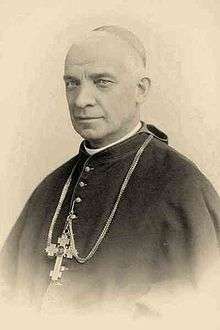
Protectors:
- 1523–1531: Lorenzo Pucci
- 1532–1535: Giovanni Salviati
- 1540–1542: Girolamo Aleander
- 1542–1555: Marcello Cervini
- 1555–1580: Giovanni Girolamo Morone
- 1580–1600: Andreas von Österreich
- 1603–1634: Franz von Dietrichstein
- 1635–1638: Ippolito Aldobrandini
- 1638–1642: Maurizio di Savoia
- 1655–1667: Ernst Adalbert von Harrach
- Federico Sforza (1664–1666, substitute protector of Habsburg hereditary lands)[16]
- 1673–1689: Carlo Pio di Savoia
- 1689–1701: Francesco Maria de' Medici
- 1701–1707: Leopold Karl von Kollonitsch
- 1707–1712: Johann Philipp von Lamberg
- 1712–1725: Christian von Sachsen-Zeitz
- 1726–1738: Wolfgang von Schrattenbach
- 1738–1751: Sigismund von Kollonitsch
- 1751–1758: Ferdinand Julius von Troyer
- 1779–1800: František Herczan
- 1823–1834: Giuseppe Albani
- 1858–1867: Pietro Silvestri
Vice-protectors and co-protectors
- 1536–1541: Alessandro Cesarini
- 1560–1565: Cristoforo Madruzzo
- 1571: Marcantonio Colonna
- 1574/ 1580/81: Tolomeo Galli
- 1581–1603: Alfonso Gesualdo
- 1584–1587: Antonio Carafa
- 1604–1607: Alfonso Visconti
- 1607–1611: Ottavio Paravicini
- 1612–1621: Pietro Aldobrandini
- 1621–1632: Ludovico Ludovisi
- 1629–1631: Cosimo de Torres
- 1635–1641: Carlo Emanuele di Savoia
- 1642–1644: Alfonso de la Cueva
- 1644–1655: Ernst von Harrach
- 1645–1664: Girolamo Colonna
- 1664–1667: Fedrigo Sforza
- 1667–1675: Friedrich von Hessen-Darmstadt
- 1690–1693: José Saenz d'Aguirre
- 1694–1700: Francesco del Guidice
- 1701/02/ 1706–1710: Vincenzo Grimani
- 1703–05/ 1708–12: Fabrizio Paolucci
- 1713–1719: Wolfgang von Schrattenbach
- 1719–1722: Michael Friedrich von Althan
- 1722–1726: Alvaro Cienfuegos
- 1735–1743: Niccolò del Giudice
- 1743–1779: Alessandro Albani
Of England
Of Ireland
- Girolamo Ghinucci (1539–1541)
- Rodolfo Pio di Carpi (1545–1554)
- Giovanni Girolamo Morone (1555? – 1574?)
- Francesco Alciati (1574–1580)[17]
- Flavio Orsini (1580–1581)
- Nicholas Pelleve (1582–1594)
- Girolamo Mattei (1594? – 1603)
- Pompeo Arrigoni (1605–1616)
- Fabrizio Veralli (1616? – 1624)
- Ludovico Ludovisi (1625–1632)[18]
- Antonio Barberini (1633? – 1671)
- Paluzzo Paluzzi Altieri degli Albertoni (1671–1698)
- Giuseppe Renato Imperiali (1706–1737)
- Neri Maria Corsini (1737–1770)
- Mario Marefoschi (1771–1780)
- Gregorio Salviati (1781–1794)
- Carlo Livizzani (1794–1802)
Of Scotland
- Antoniotto Pallavicini (1504–1507)
- Pietro Accolti (1514–1532)
- Benedetto Accolti (1532–1538)
- Rodolfo Pio di Carpi (1538–1549)
- Giovanni Domenico de Cupis (1550–1553)[19]
- Niccolo Caetani Sermoneta (1570–1585)
- Camillo Borghese (1603–1605)
- Maffeo Barberini (1608–1623)
- Francesco Barberini (1623–1679)
- Phillip Howard of Norfolk (1680–1694)
- Taddeo da Verme (1706–1717)
- Alessandro Falconieri (1727–1734)
- Domenico Riviera (1734–1752)
- Giuseppe Spinelli (1754–1763)
- Giovanni Francesco Albani (1763–1803)
- Charles Erskine (1804–1811)
Of France

The King of France historically had only one cardinal protector at a time,[16] chosen by a complicated process that involved the King, the secretary of state for foreign affairs, the French ambassador to Rome, and other French power brokers, but not the pope.[20] The crown-cardinal of France was also abbot commendatario of several French abbeys.[21]
There was traditionally at least one resident French cardinal in the Roman Curia during the first half of the sixteenth century, but Louis XII and Francis I chose three successive Italian cardinals as protector of France thereafter.[7]
- 1513–1516: Federico di Sanseverino
- 1516–1523: Giulio de Medici
- 1523–1548: Agostino Trivulzio
- Niccolò Gaddi (vice-protector from 1533)[22]
- 1549–1572: Ippolito II d'Este[23][24]
- 1573–1586: Luigi d'Este
- 1587–1615: François de Joyeuse
- Vice-protector Arnaud d'Ossat (1599–1604)
- Vice-protector François de La Rochefoucald (October 1609–May 1611)[25]
- 1616–1620: Alessandro Orsini
- Guido Bentivoglio (vice-protector from 1621 until 1636)[20]
- 1621–1636: Maurizio di Savoia
- 1636–1644: Antonio Barberini
- 1645–1672: Rinaldo d'Este
- Alessandro Bichi (vice-protector 1645 until 1657)
- 1672–1676: Virginio Orsini (from 1646 acted as co-protector)
- 1676–1701: César d'Estrées
- 1702–1709: Francesco Maria de’Medici
- 1709–1740: Pietro Ottoboni
- Pierre Guérin de Tencin, acting protector until 1758
- 1758–1765: Prospero Colonna di Sciarra
- 1769–1792/4: François-Joachim de Pierre de Bernis
Of the Holy Roman Empire
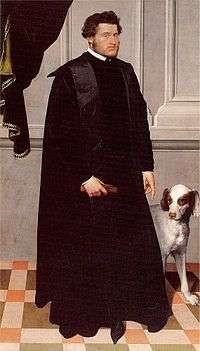
The protector of the Holy Roman Empire was often the protector of the Austrian hereditary lands.[16]
- 1492–1503: Francesco Piccolomini[26]
- 1518–1539: Lorenzo Campeggio
- 1540: Pedro Manriquez
- 1540–1542: Girolamo Aleander
- 1542–1550: Innocenzo Cibo
- 1550–1557: Juan Álvarez de Toledo
- 1557–1573: Otto Truchsess von Waldburg
- 1573–1600: Ludovico Madruzzo
- 1603–1611: Ottavio Paravicini
- 1611–1633: Scipione Borghese
- 1635/36: Franz von Dietrichstein[27]
- 1636–1642: Moritz von Savoyen
- 1644–1666: Girolamo Colonna
- 1666–1682: Friedrich von Hessen-Darmstadt
- 1682–1689: Carlo Pio di Savoia
- 1689–1701: Francesco Maria de' Medici[28]
- 1701–1707: Leopold von Kollonitsch
- 1707–1712: Johann Philipp von Lamberg
- 1712–1725: Christian August von Sachsen-Zeitz
- 1726–1738: Wolfgang von Schrattenbach
- 1738–1751: Sigismund von Kollonitsch
- 1751–1758: Ferdinand Julius von Troyer
- 1758–1765: vakant
- 1765–1779: Alessandro Albani
- 1779–1800: Franziskus von Paula Herzan von Harras
Vice-protectors and co-protectors
- 1517–1530: Lorenzo Pucci
- 1530–1532: Wilhelm van Enkevoirt
- 1534–1539: Alessandro Cesarini
- 1538–1540: Girolamo Ghinucci
- 1540–1542: Alessandro Farnese
- 1542–1550: Juan Álvarez de Toledo
- 1550–1553: Bernardo Maffei
- 1557–1559: Pedro Pacheco
- 1558–1568: Clemente Dolera
- 1587–1593: Filippo Spinola
- 1594–1600: Ottavio Paravicini
- 1621–1625: Eitel Friedrich von Hohenzollern
- 1625–1644: Giulio Savelli
- 1644: Girolamo Colonna
- 1664–1666: Federico Sforza (substitute protector)[16]
- 1666–1682: Carlo Pio di Savoia
- 1690–1693: José Saenz d'Aguirre
- 1694–1700: Francesco del Guidice
- 1701/02/ 1706–1710: Vincenzo Grimani
- 1703–05/ 1708–12: Fabrizio Paolucci
- 1713–1719: Wolfgang von Schrattenbach
- 1719–1722: Michael Friedrich von Althan
- 1722–1726: Alvaro Cienfuegos
- 1735–1743: Niccolò del Giudice
- 1745–1765: Alessandro Albani
Of Poland
- Pedro Isvalies (ca. 1506 — 1511)
- Achille de Grassi (1512–1523)
- Lorenzo Pucci (1523–1531)[29]
- Antonio Pucci (1532–1544)
- Alessandro Farnese (1544–1589)[30]
- Bernardino Maffei (vice-protector 1550–1553)
- Giacomo Puteo (vice-protector 1555–1563)
- Giacomo Savelli (vice-protector 1563–1587)
- Alessandro Peretti di Montalto (1589–1623)
- Cosimo de Torres (vice-protector 1622–1623, protector 1623–1642)
- Giulio Savelli (1642–1644)
- Gianbattista Pamphilj (vice-protector until 1644)
- Gaspare Mattei (1644–1650)
- Virginio Orsini (co-protector 1647–1650, protector 1650–1676)
- Pietro Vidoni (co-protector 1676, protector 1676–1681)
- Carlo Barberini (1681–1704)
- Annibale Albani (1712–1751)
- Gian Francesco Albani (1751–1795)
Of Sweden
Cardinal-protectors of Sweden were appointed by king of Poland Zygmunt III Waza, who had claimed the rights to the Swedish Crown.[31]
- Odoardo Farnese (1601–1626)
- Lorenzo Magalotti (1626–1637)
Of Portugal
- 1517–1531: Lorenzo Pucci
- 1533–1544: Antonio Pucci
- 1545–1564: Guido Ascanio Sforza
- 1565–1572: Carlo Borromeo
- 1573–1589: Alessandro Farnese
- 1591–1603: Alfonso Gesualdo
- 1604–1626: Odoardo Farnese
- 1626–1634: Francesco Barberini
- 1635–1638: Ippolito Aldobrandini
- 1657–1676: Virginio Orsini
- 1676–1714: César d'Estrées
- 1714–1721: Michelangelo Conti
- 1739–1770: Neri Maria Corsini
- 1859–1884: Camillo di Pietro
- 1887–1888: Włodzimierz Czacki
- 1891–1910/30: Vincenzo Vannutelli
Of Savoy/Kingdom of Sardinia
Protectors of the Duchy of Savoy
- 1534–1537: Paolo Cesi[19]
- 1576–1594: Michele Bonelli
- 1594–1621: Pietro Aldobrandini
- 1621–1632: Ludovico Ludovisi
- 1633–1671: Antonio Barberini
- 1671–1704: Carlo Barberini
Protectors of the Kingdom of Sardinia
- 1727–1779: Alessandro Albani
- 1819? – 1834: Giuseppe Albani
- 1835–1853: Luigi Lambruschini
Of Naples
- 1530–1542: Alessandro Cesarini
- 1544–1549: Alessandro Farnese
- 1556–1564: Guido Ascanio Sforza
- 1566–1574: Alessandro Sforza
- 1574–1603: Alfonso Gesualdo
- 1605–1608: Ascanio Colonna
- 1608–1642: Girolamo Doria
- 1644–1650: Gaspare Mattei
- 1657–1663: Camillo Astalli
- 1664–1676: Federico Sforza[16]
- 1689–1699: José Saenz d'Aguirre
Of Sicily
- 1524–1542: Alessandro Cesarini
- 1542–1589: Alessandro Farnese
- 1592–1626: Odoardo Farnese
- 1626–1634: Francesco Barberini
- 1635–1642: Luigi Caetani
- 1645–1656: Pier Donato Cesi
- 1664–1687: Lorenzo Raggi
- Federico Sforza (1664–1666, substitute protector)[16]
- 1687–1699: José Saenz d'Aguirre
- 1699–1725: Francesco del Giudice
Of the Kingdom of Two Sicilies
- 1738–1747: Troiano Acquaviva d'Aragona[32]
- 1747–1789: Domenico Orsini
- 1789–1795: Ferdinando Spinelli
- 1799–1806?: Fabrizio Dionigi Ruffo
Of Castile/Spain

The King of Spain could have as many as five or six cardinal protectors (Spanish: Protector de España) simultaneously, although traditionally the protector of Castile was the most frequently turned to.[16]
- 1516–1517: Francisco Remolins
- 1517–1529: Lorenzo Pucci
- 1529–1534: Andrea della Valle
- 1534–1563: Ercole Gonzaga
- 1563–1566: Francesco Gonzaga
- 1566–1574: Francisco Pacheco de Toledo[33]
- 1574–1581: Alessandro Sforza[17]
- 1582–1588: Ferdinando de' Medici[34]
- Francesco Alciati (Vice-protector circa 1569)[17]
- 1588–1592: Juan Hurtado Mendoza[35]
- 1592–1599: Pedro de Deza Manuel[36]
- 1599–1601: Alessandro d'Este
- 1601–1606: Francisco de Ávila[37]
- 1606–1617: Antonio Zapata y Cisneros
- 1617–1632: Gaspar de Borja y Velasco
- 1632–1645: Gil Carrillo de Albornoz
- 1645–1666: Carlo de' Medici
- Federico Sforza (1664–1667, substitute protector)[16]
- 1667–1672: Friedrich von Hessen-Darmstadt
- 1673–1677: Luis Manuel Portocarrero
- 1677–1689: Carlo Pio di Savoia
- 1689–1702: Francesco Maria de' Medici
- 1702–1713?: Francesco del Giudice
- 1713–1725: Francesco Acquaviva d'Aragona[38]
- 1725–1743: Luis Antonio Belluga y Moncada
- 1743–1747: Troiano Acquaviva d'Aragona[32]
- 1748–1760: Joaquin Fernandez Portocarrero
Of Aragon
- 1517–1531: Lorenzo Pucci
- 1531–1542: Alessandro Cesarini
- 1542–1589: Alessandro Farnese
- 1592–1626: Odoardo Farnese
- 1626–1634: Francesco Barberini
- 1635–1641: Carlo Emanuele Pio di Savoia
- 1645–1666: Girolamo Colonna
- 1666–1682: Friedrich von Hessen-Darmstadt
- 1682–1689: Carlo Pio di Savoia
- 1689–1702: Francesco Maria de’Medici
Of Flanders
- 1561–1572: Carlo Borromeo
- 1573–1597: Marcantonio Colonna
- 1597–1608: Ascanio Colonna
- 1608–1633: Scipione Caffarelli-Borghese
- 1633–1642: Pietro Maria Borghese
- 1644–1666: Girolamo Colonna
- Federico Sforza (1664–1666, substitute protector)[16]
- 1669–1676: Friedrich von Hessen-Darmstadt
- 1677–1689: Carlo Pio di Savoia
- 1689–1702: Francesco Maria de' Medici
List of other national cardinal protectors
Of Switzerland
- Carlo Borromeo (1560–1572)[39]
- Paolo Emilio Sfondrati (1591–1618)
- Odoardo Farnese (1618–1626)
- Francesco Barberini (1626–1679)[16]
- Carlo Barberini (1680–1704)
- Fabrizio Spada (1712–1717)
- Annibale Albani (1717–1751)
Of Republic of Genoa
- Giandomenico Spinola (1626–1630)[40]
- Laudivio Zacchia (1631–1637)[41]
- Pietro Maria Borghese (1638–1642)[42]
List of non-cardinal protector crown-cardinals
- Of Austria
- Andrew of Austria, son of Archduke Ferdinand[43]
- Joseph Dominicus von Lamberg (December 20, 1737 – August 30, 1761)[44]
- Rudolf of Austria (June 4, 1819 – July 24, 1831), Archbishop of Olomouc, Archduke
- Carlo Gaetano Gaisruck (Papal conclave circa 1846)
- Jan Maurycy Pawel Puzyna de Kosielsko (Papal conclave circa 1903)
- Of Bavaria
- Philipp Wilhelm (22 September 1576 – 18 May 1598), Bishop of Regensburg from 1595, Cardinal from 1597[45]
- Johann Casimir v. Häffelin (6 April 1818 – 27 August 1827), Ambassador of Bavaria to the Holy See (since 18 November 1803), probably a de facto court bishop since 11 November 1787 (as general vicar of the Bavarian Priory of the Order of Malta)
- Of England
- Charles of Guise, uncle of Mary, Queen of Scots[43]
- Of France
- Jean Jouffroy, continued role as procurator after elevation as cardinal[7]
- Jean Balue, continued role as procurator after elevation as cardinal; styled as "French protector" in Rome[7][46]
- André d'Espinay (March 9, 1489 – November 10, 1500)[47]
- Armand Jean de Richelieu (November 3, 1622 – December 4, 1642), Bishop of Luçon, Prime Minister
- Jules Mazarin (1641–1661)
- Jean Siffrein Maury (1794–1806), Archbishop of Montefiascone, representative of the Bourbon pretender, sided with Napoleon I in 1806
- Joseph Fesch (2 December 1804 – 22 June 1815), Archbishop of Lyons, step-uncle to Napoleon I, Ambassador of France to the Holy See (1803–1806, but in 1803 there wasn't as yet a crown) and Imperial Grand Almoner (1805–1814); his role as crown-cardinal ended with the end of the Napoleonic reign, whereas he remained Cardinal and Archbishop
- Of the Holy Roman Empire
- Of Poland
- Jerzy Radziwiłł (1556–1600)
- Jan Aleksander Lipski (December 20, 1737 – February 20, 1746)[44]
- Of Portugal
- Cardinal-Infante Afonso of Portugal
- Henry of Portugal
- Tomás de Almeida (December 20, 1737 – February 27, 1754)[44][48]
- Of Spain
- Pedro González de Mendoza (May 7, 1473 – January 11, 1495)[47]
- Francisco Jiménez de Cisneros
- Cardinal-Infante Ferdinand
- Luis Antonio Jaime de Borbón y Farnesio (December 19, 1735 – December 18, 1754)[49]
- Francisco de Solís Folch de Cardona (April 5, 1756 – March 21, 1775)[50]
- Of Tuscany
See also
- Prince of the Church
- Prince-Bishop
- Lord Bishop
- Cardinal-nephew
- Lay cardinal
- Henry Benedict Stuart, Called Cardinal Duke of York, recognized by the Jacobites as King Henry IX.
References
- Baumgartner, Frederic J. 2003. Behind Locked Doors: A History of the Papal Elections. Palgrave Macmillan. ISBN 0-312-29463-8.
- Pastor, Ludwig. 1902. The History of Popes. K. Paul, Trench, Trübner & Co., Ltd.
- Wilkie, William E. 1974. The cardinal protectors of England. Cambridge University Press.
- Girgensohn, Dieter (1977). "Wie wird man Kardinal? Kuriale und aujierkuriale Karrieren an der Wende des 14. zum 15. Jahrhundert". Quellen und Forschungen aus Italienischen Archiven und Bibliotheken. 57: 138–162.
- Peter Tusor, "Prolegomena zur Frage des Kronkardinalats," Archivum Historiae Pontificiae Volume 41 (2003), pp. 51–71.
Notes
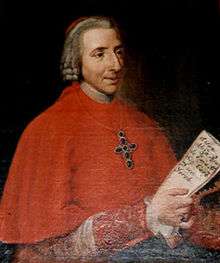
- 1 2 Chadwick, Owen; pp. 265–267.
- 1 2
 Herbermann, Charles, ed. (1913). "Cardinal". Catholic Encyclopedia. New York: Robert Appleton Company.
Herbermann, Charles, ed. (1913). "Cardinal". Catholic Encyclopedia. New York: Robert Appleton Company. - ↑ Reinerman, Alan J. 1989. Austria and the Papacy in the Age of Metternich. Washington, D.C.: Catholic University of America Press. p. 59.
- ↑
 Herbermann, Charles, ed. (1913). "Right of Exclusion". Catholic Encyclopedia. New York: Robert Appleton Company.
Herbermann, Charles, ed. (1913). "Right of Exclusion". Catholic Encyclopedia. New York: Robert Appleton Company. - ↑ Francis A. Burkle-Young. 1998. "The Cardinals of the Holy Roman Church: Papal elections in the Fifteenth Century: The election of Pope Eugenius IV (1431)."
- 1 2 Baumgartner, 2003, p. 150.
- 1 2 3 4 5 Wilkie, 1974, p. 8.
- 1 2 Wilkie, 1974, p. 9.
- ↑ Bireley, Robert. 2007. Book Review. The Catholic Historical Review. 93, 1: 172–173. A manuscript list of cardinals appointed at the request of Crowns can be found in the Vatican Library in the Borghese collection, Borg. lat. 376, pp. 131-141: Pietro Francesco de Rossi, De cardinalibus electis ad preces Principum, ab anno 1294 usque in finem pontificatus Pauli III.
- ↑ Burkle-Young, Francis A. 1998. "The election of Pope Nicholas V (1447)."
- 1 2 3
 Herbermann, Charles, ed. (1913). "Cardinal Protector". Catholic Encyclopedia. New York: Robert Appleton Company.
Herbermann, Charles, ed. (1913). "Cardinal Protector". Catholic Encyclopedia. New York: Robert Appleton Company. - ↑ Signorotto and Visceglia, 2002, p. 161
- 1 2 3 Miranda, Salvator. 1998. "The election of Pope Eugenius IV (1431)."
- ↑ Pastor, 1940, p. 133.
- ↑ Wodka, Josef. Zur Geschichte der nationalen Protektorate der Kardinäle an der römischen Kurie. [publisher omitted]: Innsbruck and Leipzig, 1938, 46–130.
- 1 2 3 4 5 6 7 8 9 10 Signorotto, Gianvittorio, and Visceglia, Maria Antonietta. 2002. Court and Politics in Papal Rome, 1492–1700. Cambridge University Press. ISBN 0-521-64146-2. p. 163
- 1 2 3 Miranda, Salvator. 1998. "Consistory of March 12, 1565 (IV)"
- ↑ Gillis, Clive. 2004. "Days of Deliverance Part 9: Rome makes the New Irish Confederation invincible."
- 1 2 Miranda, Salvator. 1998. "Consistory of July 1, 1517 (V)."
- 1 2 Signorotto and Visceglia, 2002, p. 164.
- ↑ Salvator, Miranda. 1998. "Consistory of November 7, 1689."
- ↑ Miranda, Salvator. 1998. "Consistory of May 3, 1527 (I)."
- ↑ Signorotto and Visceglia, 2002, pp. 164–165.
- ↑ Yardley, Jonathan. 2005, June 26. "The Cardinal's Hat." Washington Post. BW02.
- ↑ Miranda, Salvator. 1998. "Consistory of December 10, 1607 (III)."
- ↑ Signorotto and Visceglia, 2002, p. 29
- ↑ Miranda, Salvator. 1998. "Consistory of March 3, 1599 (IV)"
- ↑ Miranda, Salvator. 1998. "September 2, 1686 (II)"
- ↑ Miranda, Salvator. 1998. "Consistory of September 23, 1513 (I)"
- ↑ pl:Alessandro Farnese (1520-1589)
- ↑ Wodka, p. 124
- 1 2 Miranda, Salvator. 1998. "Consistory of October 1, 1732 (IV)"
- ↑ Miranda, Salvator. 1998. "Consistory of February 26, 1561 (II)"
- ↑ Minnich, Nelson H. 2003. Book Review. The Catholic Historical Review. 89, 4: 773–778
- ↑ Miranda, Salvator. 1998. "Consistory of December 18, 1587 (V)"
- ↑ Miranda, Salvator. 1998. "Consistory of February 21, 1578 (V)"
- ↑ Miranda, Salvator. 1998. "Consistory of September June 5, 1596 (II)"
- ↑ Miranda, Salvator. 1998. "Consistory of May 17, 1706 (II)."
- ↑ Miranda, Salvator. 1998. "Consistory of January 31, 1560 (I)"
- ↑ Miranda, Salvator. 1998. "Consistory of January 19, 1626 (III)"
- ↑ Miranda, Salvator. 1998. "Consistory of January 19, 1626 (III)"
- ↑ Miranda, Salvator. 1998. "Consistory of October 7, 1624 (II)"
- 1 2 3 Trollope, 1876, p. 51.
- 1 2 3 Baumgartner, Frederic J. 2003. Behind Locked Doors: A History of the Papal Elections. Palgrave Macmillan. ISBN 0-312-29463-8 p. 173
- ↑ Trollope, 1876, p. 52.
- ↑ Wilkie, 1974, p. 16.
- 1 2 Burke-Young, Francis A. 1998. "The election of Pope Alexander VI (1492)"
- ↑ Minor, Vernon Hyde. 2005. The Death of the Baroque and the Rhetoric of Good Taste. Cambridge University Press. ISBN 0-521-84341-3. p. 138
- ↑ Pastor, 1941, p. 405
- ↑ Robinson, Nancy Nowakowski. 2004. Institutional Anti-Judaism. Xlibris. ISBN 1-4134-2161-X. p. 75



.jpg)